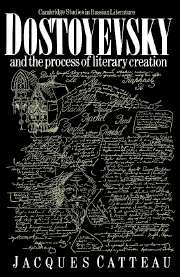Book contents
- Frontmatter
- Contents
- Preface to the English edition
- List of abbreviations
- General editor's note on transliteration and references
- General introduction
- PART I The creative environment
- PART II The process of creation
- Part III Time and space in the world of the novels
- Introduction
- 19 The master of men and hours
- 20 Chronology and temporality in The Idiot
- 21 The ascending spiral
- 22 Time of power and power of time
- 23 The havens of eternity
- 24 The dream of space and the space of the real
- 25 The inventory and the expressionist orchestration of scenery and lighting
- 26 The semantics of colour
- 27 The hero in space: sighting and seeing
- Conclusion
- Notes
- Select bibliography
- Index of names
22 - Time of power and power of time
Published online by Cambridge University Press: 18 December 2009
- Frontmatter
- Contents
- Preface to the English edition
- List of abbreviations
- General editor's note on transliteration and references
- General introduction
- PART I The creative environment
- PART II The process of creation
- Part III Time and space in the world of the novels
- Introduction
- 19 The master of men and hours
- 20 Chronology and temporality in The Idiot
- 21 The ascending spiral
- 22 Time of power and power of time
- 23 The havens of eternity
- 24 The dream of space and the space of the real
- 25 The inventory and the expressionist orchestration of scenery and lighting
- 26 The semantics of colour
- 27 The hero in space: sighting and seeing
- Conclusion
- Notes
- Select bibliography
- Index of names
Summary
Time, the mark of my impotence, the extent of my power
Jules Lagneau, Fragment 40The false abolition of time
In all his great novels, with increasing success which culminates in The Brothers Karamazov, Dostoyevsky felt the imperious need to compress and accelerate time, to direct it in a spiralling flight of demented rhythm. Why this painful haste? Is time the suffering of the creature? Is the incredible acceleration of rhythm intended to abolish time?
Bakhtin's thesis is that time is abolished in favour of space. He writes:
This characteristic finds its external expression in Dostoyevsky's taste for crowd scenes, in his tendency to concentrate in one single place at one single moment, often in contradiction of practical likelihood, the greatest number of characters and the greatest number of subjects, i.e. to concentrate in one instant the greatest possible qualitative diversity. This is another reason for Dostoyevsky's tendency to observe dramatic unity of time in the novel. It causes the speed of action rushing towards catastrophe, the whirlwind movement, the dynamics of Dostoyevsky. Dynamics and speed here (as everywhere else) are not the triumph of time, but time overtaken, for speed is the only way of overtaking time during time.
This is a just and subtle observation: the famous gatherings, where hoards of characters, arranged with directorial strictness in a drawing room, in a square, or in front of a church, live through those intense and violent moments which would take whole chapters in another novel, or the assemblies, like that in the plan for The Life of a Great Sinner', which bring together thinkers and writers from different ages, are perfect illustrations of Bakhtin's idea.
- Type
- Chapter
- Information
- Dostoyevsky and the Process of Literary Creation , pp. 363 - 371Publisher: Cambridge University PressPrint publication year: 1989



